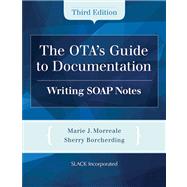With the current changes in health care, proper documentation of client care is essential in meeting the legal, ethical, and professional standards for reimbursement of services. Written specifically for occupational therapy assistants, The OTA’s Guide to Documentation: Writing SOAP Notes, Third Edition contains the step-by-step instruction needed to learn the documentation required for occupational therapy clinical practice and reimbursement.
Written in an easy-to-read format, this Third Edition by Marie J. Morreale and Sherry Borcherding allows occupational therapy assistants to learn the purpose and standards of documentation throughout all stages of the occupational therapy process and in a variety of practice settings.
New features in the Third Edition:
· Incorporation of the Occupational Therapy Practice Framework: Domain and Process, Second Edition along with other updated American Occupational Therapy Association documents
· Electronic documentation information
· Information on International Classification of Functioning, Disability, and Health language
· Information on narrative notes with examples
· A new chapter on “Billing and Reimbursement” with a focus on funding sources and requirements
· More information and examples for pediatric, school-based, and mental health practice settings
· Information on quality measures
· New worksheets for developing occupational therapy goals
· Additional worksheets on documentation mistakes and basics of documentation
· A new method of goal writing (COAST)
· Lists of professional language
This text teaches the SOAP notes format reimbursable by Medicare Part B and other third party payers. Other topics include a review of spelling and grammar, an overview of the initial evaluation process delineating the roles of the occupational therapist and the occupational therapy assistant, tips for clinical reasoning, and guidelines for selecting appropriate interventions.
Instructors in educational settings can visit www.efacultylounge.com for additional material to be used in the classroom.
The OTA’s Guide to Documentation: Writing SOAP Notes, Third Edition offers both the necessary instruction and multiple opportunities to practice. Templates allow beginning students to practice formatting SOAP notes, and a detachable summary sheet can be pulled out and carried to clinical sites as a reminder of the necessary contents for a SOAP note. Multiple worksheets are provided for practice in developing observation skills, clinical reasoning, documentation skills, and a repertoire of professional language. All worksheets in this Third Edition are available online, with answers included to enable independent study. Occupational therapy assistant students and faculty as well as practicing occupational therapy assistants and rehabilitation professionals will appreciate this valuable text.
As a bonus:
When you purchase a new copy of The OTA’s Guide to Documentation: Writing SOAP Notes, Third Edition, you will receive access to scenario-based videos to practice the documentation process.









